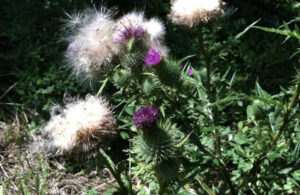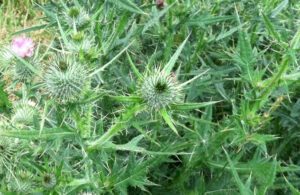Bull Thistle
Bull Thistle
Cirsium Vulgare
Bull thistle is one of Colorado’s List B thistles. Originally from Europe, Asia, and Northern Africa, it is now found in all 50 states. It invades native grasslands and rangelands, reducing the forage that wildlife and livestock depend on.
Its dark green deeply lobbed leaves distinguish it from the other native and invasive thistles. Its flowers are urn-shaped and light purple with spiny bracts and can be seen June-September. The 1.5-inch-wide flowers grow at the end of branches, usually singly but sometimes in small groups.
Because they are biennials, the plants spend their first year as a rosette (seedling). In the second year, they form a central stalk that branches as it matures. Plants can grow to seven feet tall but are usually 3-4 feet tall. Stems are winged and spiny.
Herbicide is most effective in the fall at the rosette stage or in the spring through the early bolt stage. Treating older plants is not effective because once the flowers form, seeds will still be viable. Control this time of year is limited to removal. Flowers need to be cut, bagged, and put in the trash.
Visit Jeffco Invasive Species Management to learn more www.jeffco.us/jcism


